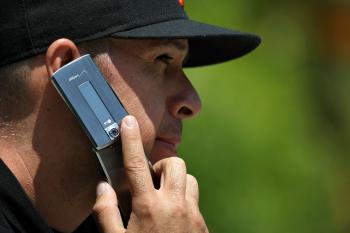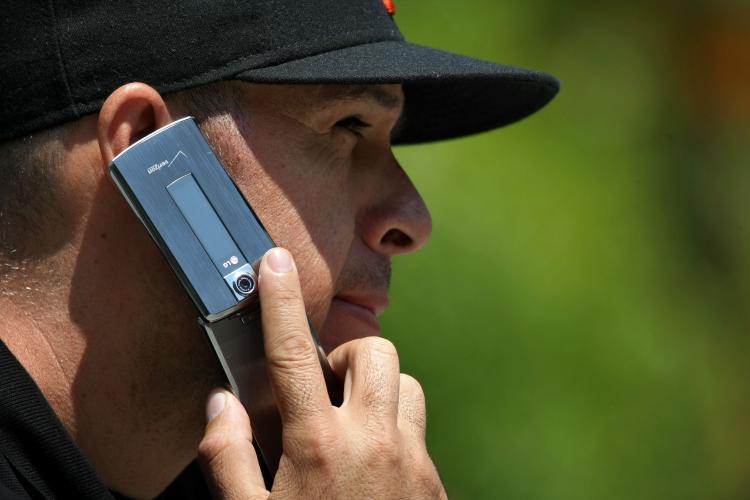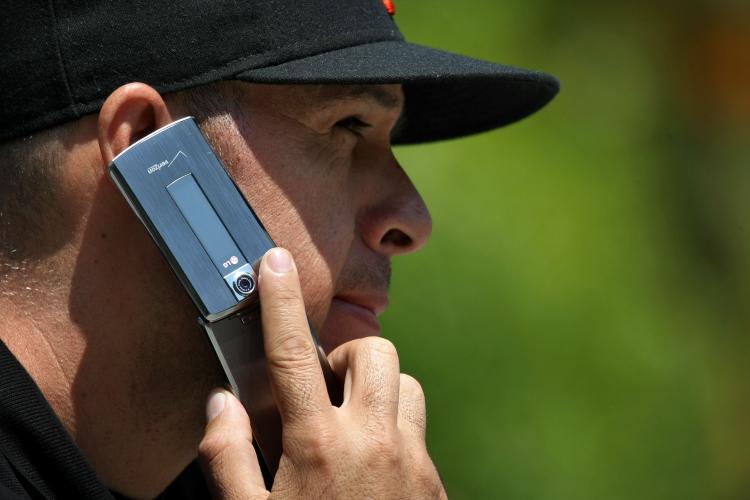Maine could be the first state in the nation to require the telecom industry to place warning labels on both cell phones and their packaging, advising women and children to keep the phone away from their heads and bodies.
State representative Andrea Boland (D-Sanford) will introduce a bill called the “Children’s Wireless Protection Act” in early 2010.
The act was written by Elizabeth Barris, founder of The People’s Initiative, a nonprofit organization with the current mission to inform the public about the harmful effects of electromagnetic radiation (EMR) released by cell phones.
She recently co-authored “Cell Phones and Brain Tumors, 15 Reasons for Concern-Science, Spin, and the Truth Behind Interphone.” (thepeoplesinitiative.org/uploads/15_Reasons_Final_Version_v8_USA.pdf)
Lloyd Morgan, a retired electrical engineer, was the primary author of the report.
The report, endorsed by at least 40 doctors, researchers, and specialists in the field of oncology, addresses the urgent need for the general public, media, and government officials to become aware of results from independent studies that find potential dangers of cell phone use.
One major assertion in the report is that both independent and industry-funded studies have found a statistically significant increased risk of brain tumors among people who use cell phones.
According to Morgan, no one in the industry has thus far refuted the report.
The risk of children and young adults using cell phones is of particular import.
One of the 15 concerns in the report is that children and young adults are the most vulnerable users, and the younger a child is when he or she begins to use a cell phone, the greater the risk.
Morgan’s report also scrutinizes the Interphone study, a 13-country study conducted from 1999 to 2004. Partially funded by the telecom industry, the Interphone study’s objective was to assess whether radiofrequency radiation exposure from cell phones is associated with tumor risk.
The Interphone study has been anticipated as the seminal study from which the
World Health Organization would base its stance on cell phone use.
Results of the study have been delayed for five years, and many believe it’s due to internal difficulties interpreting the data.
Partial results, however, have been published from a handful of the Interphone studies. Those results found that cell phone use actually protects users from getting cancer.
Morgan alleges that there are two possibilities from these findings, namely, that using a cell phone actually does protect users from brain cancer, or that the study was flawed.
He believes that the latter is more reasonable and identifies 11 design flaws in the Interphone study, including selection bias and funding bias.
Elizabeth Cardis, leader of the Interphone study, met personally with Morgan, who presented each flaw to her in June 2008. According to Morgan, she agreed with him.
Morgan feels he is a victim of EMR exposure. In 1995, he suffered a 45-minute grand-mal seizure because of a brain tumor, and for eight days, was in a critical condition. His doctor said it might have been due to electromagnetic fields.
“I worked as an electronic engineer, so after I was capable of getting around [after the seizure], I researched the science of it,” says Morgan. “I’ve found that the independent research always reports a higher risk [than the industry-funded studies].”
The goal of authoring “Cell Phones and Brain Tumors” is to take the information that’s available in the science domain and transfer it to the public, according to Morgan. “I think if the public understands what’s going on, then they'll demand that something be done. The goal is not to get rid of cell phones,” he says. “All [we] have to do is change the way we use cell phones.”
One of his suggestions is that governments mandate that all cell phones sold come with a wired headset rather than a speaker. “This way the device can always be away from the head and body,” says Morgan.
Morgan claims that the proximity of a cell phone to the head and body is an enormously important factor, and that placing the device six inches from the head results in 10,000 times less radiation absorbed in the head than when holding the device to one’s ear.
Using the speakerphone function is another suggestion. One other recommendation the report gives, which particularly targets men, is to keep the device away from the body, particularly pants or shirt pockets.
He describes the phenomenal popularity of cell phones in the last 10 years as “the largest human health experiment ever conducted without written consent on a billion people.”
Morgan is referring to the fact that no private or public agencies conducted premarketing safety testing on cell phones.
“My fear is in the brain tumors,” Morgan says. “I think the research is conclusive, with both industry and independent studies [finding] that cell phone use causes brain tumors with over 10 years of usage.
“We have 4 billion people on the planet using cell phones. The latency period [for tumors] is 30 years. If 10 percent of them get a brain tumor, that’s 400 million people. If half of them die, that’s the biggest pandemic the world has every seen.”
State representative Andrea Boland (D-Sanford) will introduce a bill called the “Children’s Wireless Protection Act” in early 2010.
The act was written by Elizabeth Barris, founder of The People’s Initiative, a nonprofit organization with the current mission to inform the public about the harmful effects of electromagnetic radiation (EMR) released by cell phones.
She recently co-authored “Cell Phones and Brain Tumors, 15 Reasons for Concern-Science, Spin, and the Truth Behind Interphone.” (thepeoplesinitiative.org/uploads/15_Reasons_Final_Version_v8_USA.pdf)
Lloyd Morgan, a retired electrical engineer, was the primary author of the report.
The report, endorsed by at least 40 doctors, researchers, and specialists in the field of oncology, addresses the urgent need for the general public, media, and government officials to become aware of results from independent studies that find potential dangers of cell phone use.
One major assertion in the report is that both independent and industry-funded studies have found a statistically significant increased risk of brain tumors among people who use cell phones.
According to Morgan, no one in the industry has thus far refuted the report.
The risk of children and young adults using cell phones is of particular import.
One of the 15 concerns in the report is that children and young adults are the most vulnerable users, and the younger a child is when he or she begins to use a cell phone, the greater the risk.
The Interphone Study
Morgan’s report also scrutinizes the Interphone study, a 13-country study conducted from 1999 to 2004. Partially funded by the telecom industry, the Interphone study’s objective was to assess whether radiofrequency radiation exposure from cell phones is associated with tumor risk.
The Interphone study has been anticipated as the seminal study from which the
World Health Organization would base its stance on cell phone use.
Results of the study have been delayed for five years, and many believe it’s due to internal difficulties interpreting the data.
Partial results, however, have been published from a handful of the Interphone studies. Those results found that cell phone use actually protects users from getting cancer.
Morgan alleges that there are two possibilities from these findings, namely, that using a cell phone actually does protect users from brain cancer, or that the study was flawed.
He believes that the latter is more reasonable and identifies 11 design flaws in the Interphone study, including selection bias and funding bias.
Elizabeth Cardis, leader of the Interphone study, met personally with Morgan, who presented each flaw to her in June 2008. According to Morgan, she agreed with him.
Morgan’s Saga
Morgan feels he is a victim of EMR exposure. In 1995, he suffered a 45-minute grand-mal seizure because of a brain tumor, and for eight days, was in a critical condition. His doctor said it might have been due to electromagnetic fields.
“I worked as an electronic engineer, so after I was capable of getting around [after the seizure], I researched the science of it,” says Morgan. “I’ve found that the independent research always reports a higher risk [than the industry-funded studies].”
The goal of authoring “Cell Phones and Brain Tumors” is to take the information that’s available in the science domain and transfer it to the public, according to Morgan. “I think if the public understands what’s going on, then they'll demand that something be done. The goal is not to get rid of cell phones,” he says. “All [we] have to do is change the way we use cell phones.”
One of his suggestions is that governments mandate that all cell phones sold come with a wired headset rather than a speaker. “This way the device can always be away from the head and body,” says Morgan.
Morgan claims that the proximity of a cell phone to the head and body is an enormously important factor, and that placing the device six inches from the head results in 10,000 times less radiation absorbed in the head than when holding the device to one’s ear.
Using the speakerphone function is another suggestion. One other recommendation the report gives, which particularly targets men, is to keep the device away from the body, particularly pants or shirt pockets.
He describes the phenomenal popularity of cell phones in the last 10 years as “the largest human health experiment ever conducted without written consent on a billion people.”
Morgan is referring to the fact that no private or public agencies conducted premarketing safety testing on cell phones.
“My fear is in the brain tumors,” Morgan says. “I think the research is conclusive, with both industry and independent studies [finding] that cell phone use causes brain tumors with over 10 years of usage.
“We have 4 billion people on the planet using cell phones. The latency period [for tumors] is 30 years. If 10 percent of them get a brain tumor, that’s 400 million people. If half of them die, that’s the biggest pandemic the world has every seen.”







Friends Read Free